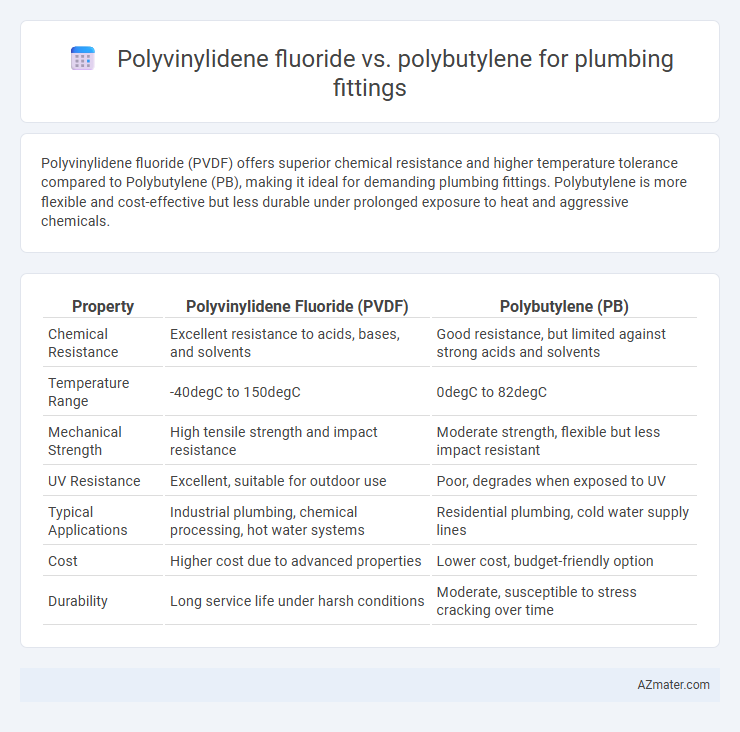Polyvinylidene fluoride (PVDF) offers superior chemical resistance and higher temperature tolerance compared to Polybutylene (PB), making it ideal for demanding plumbing fittings. Polybutylene is more flexible and cost-effective but less durable under prolonged exposure to heat and aggressive chemicals.
Table of Comparison
| Property | Polyvinylidene Fluoride (PVDF) | Polybutylene (PB) |
|---|---|---|
| Chemical Resistance | Excellent resistance to acids, bases, and solvents | Good resistance, but limited against strong acids and solvents |
| Temperature Range | -40degC to 150degC | 0degC to 82degC |
| Mechanical Strength | High tensile strength and impact resistance | Moderate strength, flexible but less impact resistant |
| UV Resistance | Excellent, suitable for outdoor use | Poor, degrades when exposed to UV |
| Typical Applications | Industrial plumbing, chemical processing, hot water systems | Residential plumbing, cold water supply lines |
| Cost | Higher cost due to advanced properties | Lower cost, budget-friendly option |
| Durability | Long service life under harsh conditions | Moderate, susceptible to stress cracking over time |
Overview of Polyvinylidene Fluoride (PVDF) and Polybutylene
Polyvinylidene fluoride (PVDF) is a high-performance thermoplastic known for its excellent chemical resistance, mechanical strength, and temperature tolerance, making it ideal for demanding plumbing fittings in industrial and chemical applications. Polybutylene (PB) offers flexibility, corrosion resistance, and ease of installation, commonly used in residential plumbing systems for water supply lines. PVDF outperforms PB in terms of durability and high-temperature resistance, while PB is more cost-effective for standard plumbing purposes.
Chemical and Physical Properties Comparison
Polyvinylidene fluoride (PVDF) exhibits superior chemical resistance to a wide range of acids, bases, and solvents compared to polybutylene (PB), making PVDF more suitable for corrosive environments in plumbing fittings. Physically, PVDF offers higher thermal stability with an operating temperature range of up to 150degC, while polybutylene typically withstands temperatures only up to 82degC. PVDF also demonstrates improved mechanical strength and UV resistance, resulting in greater durability for long-term plumbing applications.
Durability and Longevity in Plumbing Applications
Polyvinylidene fluoride (PVDF) outperforms Polybutylene (PB) in plumbing fittings due to its superior chemical resistance and high-temperature stability, ensuring enhanced durability in harsh water conditions. PVDF exhibits excellent resistance to UV degradation and mechanical stress, which extends its service life significantly compared to PB, known for its susceptibility to chlorine-induced embrittlement and premature failure. Consequently, PVDF fittings offer greater longevity and reliability in plumbing systems requiring long-term performance under demanding environmental factors.
Installation Methods and Ease of Use
Polyvinylidene fluoride (PVDF) plumbing fittings offer chemical resistance and durability with installation primarily through solvent welding, heat fusion, or mechanical joints, requiring specialized tools and moderate skill. Polybutylene (PB) fittings typically utilize compression, crimp, or push-fit connection methods, allowing for quicker, more accessible installation without extensive training or equipment. PB pipes and fittings are generally favored for ease of use in residential plumbing, while PVDF suits industrial applications demanding higher chemical and temperature resistance.
Resistance to Chemicals and Corrosion
Polyvinylidene fluoride (PVDF) exhibits superior chemical resistance compared to Polybutylene (PB), effectively withstanding aggressive acids, bases, and solvents, making it ideal for industrial plumbing applications. PVDF also offers enhanced corrosion resistance, maintaining structural integrity in harsh environments and extending service life under exposure to UV radiation and high temperatures. In contrast, Polybutylene, while flexible and cost-effective, is more susceptible to degradation from oxidizing agents and prolonged chemical exposure, limiting its use in chemically demanding plumbing systems.
Performance Under High Temperatures and Pressures
Polyvinylidene fluoride (PVDF) demonstrates superior performance under high temperatures and pressures compared to polybutylene (PB) in plumbing fittings, maintaining structural integrity up to 150degC and withstanding pressures exceeding 10 MPa. PVDF offers excellent chemical resistance and minimal thermal expansion, making it ideal for demanding industrial and chemical applications. In contrast, polybutylene typically operates effectively below 82degC and lower pressure ratings, limiting its use in high-stress environments.
Cost Analysis: PVDF vs Polybutylene
Polyvinylidene fluoride (PVDF) plumbing fittings typically exhibit higher upfront costs due to superior chemical resistance, temperature tolerance, and durability compared to polybutylene fittings, which are more budget-friendly but less resistant to cracking and degradation over time. Long-term cost analysis favors PVDF in applications involving aggressive chemicals or higher temperatures, as replacement and maintenance expenses decrease significantly. Polybutylene fittings, while initially cheaper, may incur greater lifecycle costs due to susceptibility to failure and frequent repairs in demanding plumbing systems.
Common Applications in Residential and Commercial Plumbing
Polyvinylidene fluoride (PVDF) is commonly used in residential and commercial plumbing systems for its high chemical resistance and durability in hot and corrosive water applications, making it ideal for HVAC piping and industrial water treatment. Polybutylene (PB) is favored in residential plumbing due to its flexibility, ease of installation, and cost-effectiveness, especially for hot and cold water distribution within homes. While PVDF excels in high-performance settings requiring long-term chemical stability, Polybutylene remains popular for standard water supply and plumbing repairs in both residential and light commercial environments.
Environmental Impact and Recyclability
Polyvinylidene fluoride (PVDF) plumbing fittings exhibit a lower environmental impact due to their chemical resistance and longer lifespan, reducing the need for frequent replacements and minimizing waste. Polybutylene (PB) fittings, while cost-effective, have a higher susceptibility to oxidation and biodegradation, leading to increased material waste over time. PVDF offers better recyclability options through specialized processes, whereas PB recycling is less efficient and often limited to downcycling.
Conclusion: Choosing the Right Material for Plumbing Fittings
Polyvinylidene fluoride (PVDF) offers superior chemical resistance, high temperature tolerance up to 150degC, and excellent durability, making it ideal for aggressive chemical environments and long-term use in plumbing fittings. Polybutylene (PB), while more cost-effective and flexible, is less resistant to chlorine and UV exposure, which can limit its application in certain plumbing systems. Selecting PVDF ensures enhanced performance and longevity in demanding conditions, whereas PB fits standard water supply installations where budget and ease of installation are prioritized.

Infographic: Polyvinylidene fluoride vs Polybutylene for Plumbing Fitting
 azmater.com
azmater.com